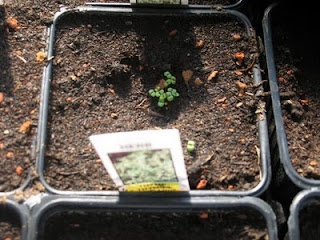On Friday, I went to a wholesale greenhouse to pick up another shipment of young plants. Below are some grasses: There is Carex Red Rooster (a grass that stays a rusty brown), Stipa Ponytails, and Juncus Curly Wurly. Also the plants for the Picasso Petunia.
And more grasses. Pennisetum "Fireworks" in the Centre, as well as many others, including Papyrus.
Colorful: Almost black Ipomea (Sweet Potato Vine--Blackie), and Lime Green Ipomea (Sweet Potato Vine--Marguerite), also a beautiful fuchsia colored grass-like plant called Rhoea.
The million bells (Calibrachoa) are filling out nicely--transplanted on Tuesday.
The begonias are happy in their large pots. They look mouldy, but they aren't--just a silvery light reflection that the camera picked up.
Just a few more of the plants to be transplanted tomorrow: Chrysanthmums, Million Bells, Osteospermum, Bacopa, Verbena, Lotus Vine, Vinca Vine, Bidens......
Tonight we set the clock ahead, so early to bed, to get at the rest of the transplants. Monday, March 15, is the heaviest seeding date of the whole season. It'll be a pleasure to see the little plants in a few weeks.Our old grand-dog, Tundra, a German shepherd, whom our son, Kubota Man Jr. retired to the farm, has a knack of always being under my feet in the greenhouse. We're learning to work around each other. This has made me aware of how observant our own dogs are--when they hear my footsteps, they look where I will be walking, and walk beside, not in front of, me. Tundra will learn, too.
Gardening hints:
1. Always freeze your cucurbit (cucumber, pumpkin, zucchini, melons, etc) type seeds over night before planting. You will have excellent germination and the sprouts will be much more vigorous. We have tested this ourselves.
2. Tomatoes like to be transplanted deeper than they were growing before--they will root all along the buried stems. BUT Peppers need to be transplanted at the same soil line as before. They do not like to be planted deeper.





















